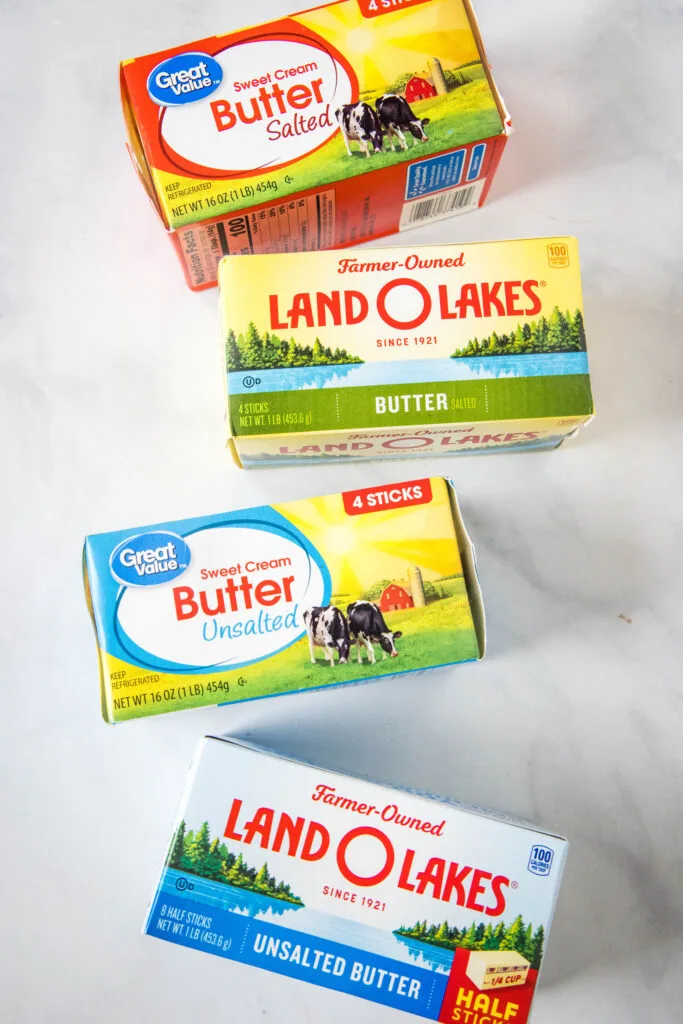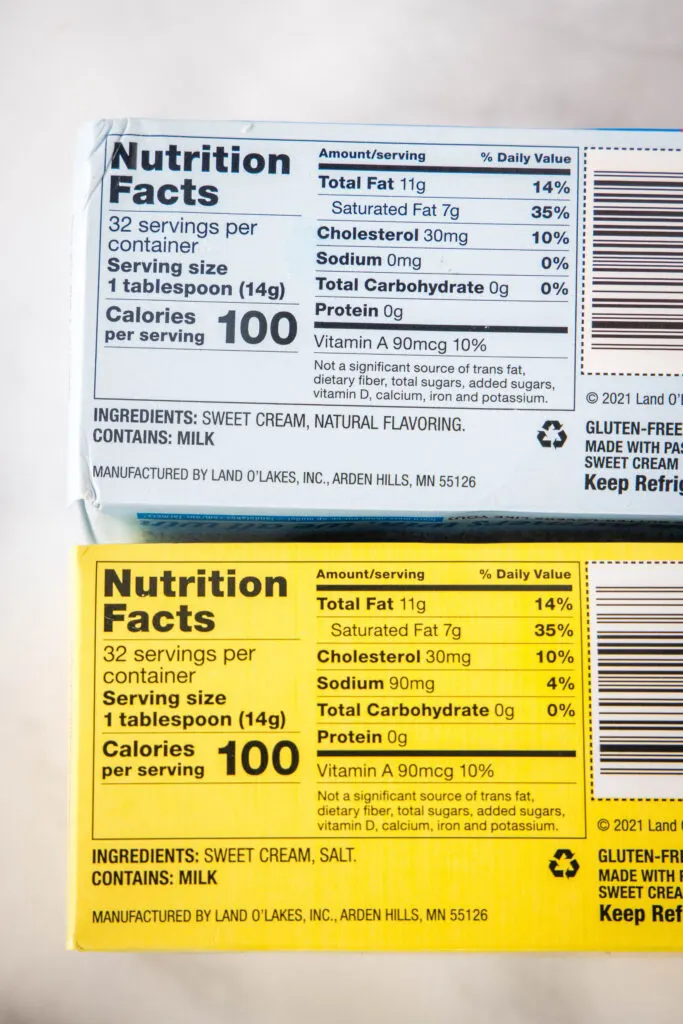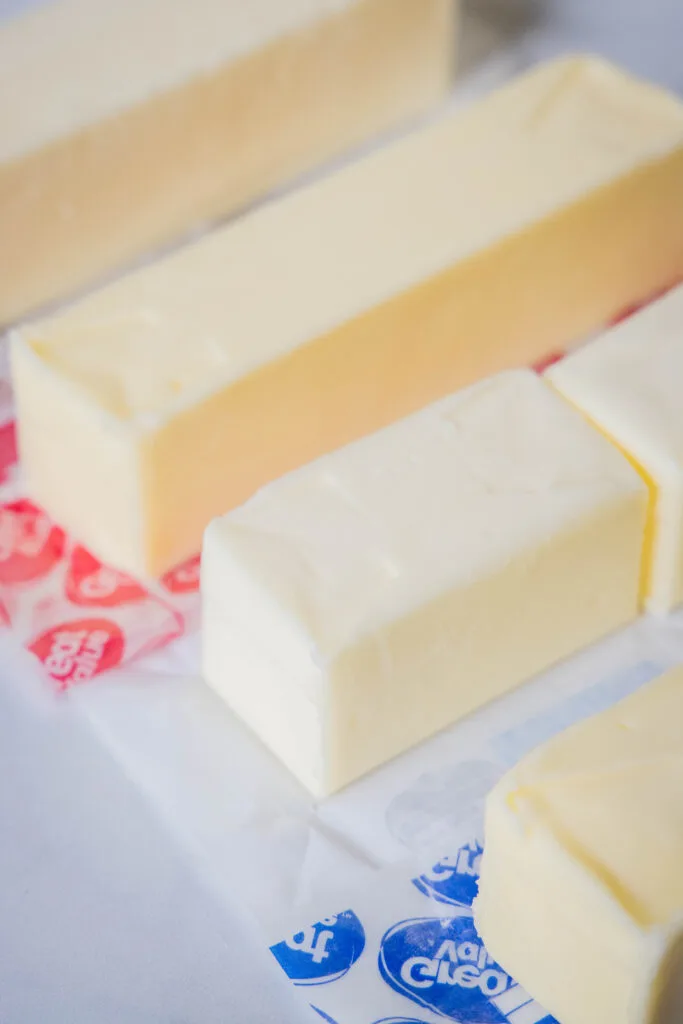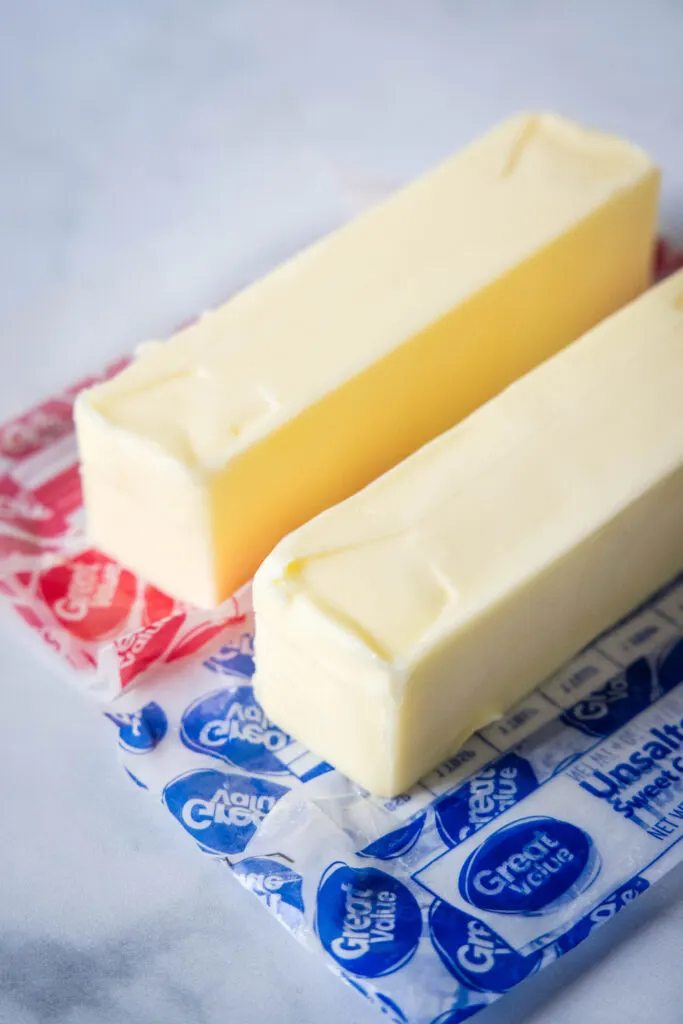Did you know there is more than just salt as the difference between Salted vs. Unsalted Butter? Which Should You Use? Find out everything you need to know for picking the best product for all of your cooking and baking needs!

Salted vs. Unsalted Butter – Which Should You Use?
It may seem like a small detail, but knowing the right time to use salted vs. unsalted butter can make or break a recipe. And I should know by now – I’ve developed and tested over 2,000 dishes for this site.
In this article, I’ll distill the lessons I’ve learned over thousands of hours of trial and error into a few simple rules to live (or at least cook) by.
Picking the right type of butter doesn’t have to be difficult, and there are a few tricks of the trade you can use if you find yourself with only the “wrong” type in a pinch.
First Of All: What’s The Big Difference Between Salted And Unsalted Butter?
Believe it or not, there is more to it than simply the salt content.
Most notably, unsalted butter is often fresher than salted butter. And that freshness can provide your dishes with a better overall flavor. The unsalted variety also has a lower water content.
I’ll unpack these and a few other critical details in their own sections below.
Salt Content
So, how much salt does “salted” butter actually contain?
I’ve found that the exact amount can vary from brand to brand, which makes salted butter more unpredictable to work with in baking recipes. As a rule of thumb, you should account for around ¼ – ½ teaspoon of salt per stick.
Using salted butter for a cooking recipe is usually less of a concern (than baking) because you can easily salt to taste at the end. When you’re making dough or batter, you won’t have the same luxury.
Unsalted butter contains zero salt, of course.
This makes it ideal for baking recipes since it lets you control the exact amount of salt in your baked goods. I don’t know about you, but I don’t want to leave the flavor up to chance when I put a lot of time and effort into baking something.

Freshness
Salt acts as a natural preservative in butter. Because of this, it extends salted butter’s shelf life by up to 4 months. Though this doesn’t guarantee that unsalted butter is always fresher when you buy it, it does increase your chances of getting a fresh batch.
Water Content
When it comes to water, salted butter often contains more of it than unsalted butter does.
For cooking recipes, the water content of butter is not super important. Savory recipes usually have more flexibility with moisture content, so the difference in a small amount of salted vs. unsalted butter shouldn’t affect your dish.
In baking recipes, though, the lower water content of unsalted butter is ideal.
If you’re baking with wheat flour, butter with less water in it helps the gluten to develop properly during mixing and kneading. This results in fluffier, crisper baked goods that hold their shape better over time.
And who wouldn’t want that?

What happens if I use salted butter instead of unsalted?
If you use salted butter in a baking recipe that calls for unsalted, you could end up with overly salty baked goods. Or, in a savory recipe, it could result in a salty sauce or other dish that’s tough to fix without watering it down too much.
The bottom line is that you get less control with salted butter. It’s nearly impossible to know how salty you’re making the dish, and at the same time, you remove any opportunity to course correct later in the recipe. Once the salt is in, it’s in for good.
While there are some ways to counteract too much salt in a dish, none of them are without consequence and most don’t work in baking. Let me explain why bakers, like me, have learned to love unsalted butter.
Why do most baking recipes call for unsalted butter?
Most baking recipes call for unsalted butter since it lets the baker have full control of the flavor of their product. Since the amount of salt in salted butter is not consistent between brands, unsalted butter allows for more flavor control and predictability.
The lower water percentage in unsalted butter also consistently creates the best results with baked goods. This fact may not seem intuitive, but I’ve seen it proven again and again in my recipe development work.
The low water percentage especially helps gluten to develop and hold its shape during baking in recipes like croissants and pie dough, and Easy Drop Biscuits. Unsalted butter will also prevent cookies like Brown Butter Toffee Chocolate Chip Cookies from spreading too much and becoming lacy.

When a recipe simply calls for “Butter,” which type should I use?
Sometimes a recipe isn’t specific about the type of butter to use, which can be confusing and frustrating. Nobody wants to mess up their recipe! Here are a few tips to help you make the best decision on whether to go with salted or unsalted butter,
When to use unsalted butter
In baking recipes, stick with unsalted butter, especially if the recipe contains added salt. This ensures your recipe won’t turn out too watery or too salty. If your baking recipe doesn’t contain any added salt, add ¼ teaspoon for each stick of butter in the recipe.
When to use salted butter, and why
In savory recipes like Pan-Seared Salmon and Creamy Mushroom Soup, it’s safe to use salted butter. When in doubt, wait until the last stage of cooking to add more salt to taste.
How to Substitute Butter
If you need to substitute the kind of butter that’s called for in a recipe, don’t worry. It is possible to do in a pinch! There are a few pointers for how to do it right and still get excellent results.
Using Salted for Unsalted Butter
Only substitute salted for unsalted butter if the recipe calls for about 2 sticks (1 cup) or less of butter. It’s always a good idea to cut the salt in the recipe when you need to substitute it with salted butter. As a general rule, subtract ¼ teaspoon of salt from the recipe for every ½ cup (1 stick) of salted butter used.
Using Unsalted for Salted Butter
If your recipe calls for salted butter and you only have unsalted, or if you just prefer unsalted butter, it’s an easy switch to make. Simply add ¼ teaspoon of salt to the recipe for each stick of unsalted butter you are using. Feel free to test the salt levels and add a little more if you think the dish needs it (in baked goods, you would need to test the dough or batter before baking it).

The Bottom Line
As a personal rule of thumb, I’d recommend that anybody start buying only unsalted butter at the grocery. These days it’s not difficult to find, is usually the same price, and it will give you flexibility across a variety of recipes to have more control over the saltiness of the final result.
Why would you want to buy “salted” butter?
Look, I’m not saying that salted butter doesn’t have its place in the world. If you’re stocking up for the long term, then salted butter may last a bit longer. Like a Costco bulk box for folks living off the grid. The salt content can also help cover up defects, preservatives, and off-flavors that you might get with some discount brands.
But, if you’ve got a choice and fresh unsalted butter is available. Try picking up a box, and don’t forget a shaker of salt while you’re at it.
- Air Fryer Chicken Burger - May 1, 2024
- Ritz Churro Bites - April 30, 2024
- Black Bean Dip - April 29, 2024

Catalina
Saturday 28th of October 2023
It's useful to know and understand all these differences between salted and unsalted butter. I usually buy only unsalted butter!
Katerina Petrovska
Friday 27th of October 2023
Great information! Thank you for sharing!
Amanda Batcher
Thursday 26th of October 2023
Wow, this is good information. Thank you for sharing!
Beth
Thursday 26th of October 2023
I had NO idea that salted butter was any different than unsalted outside of the salt content. I can't belive it's not as fresh!